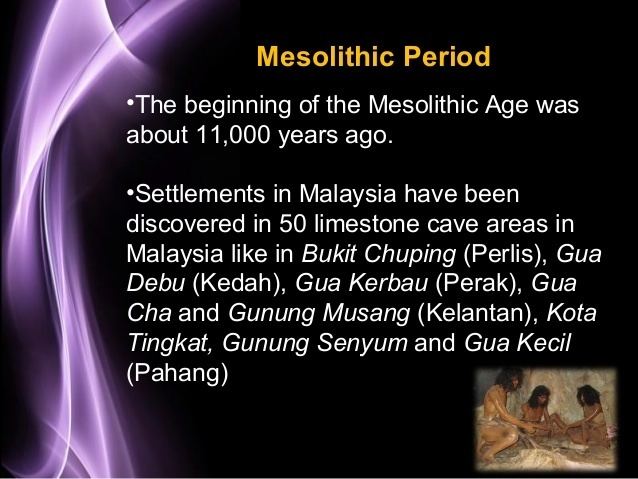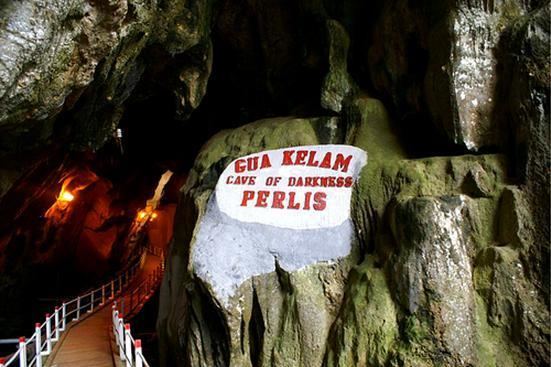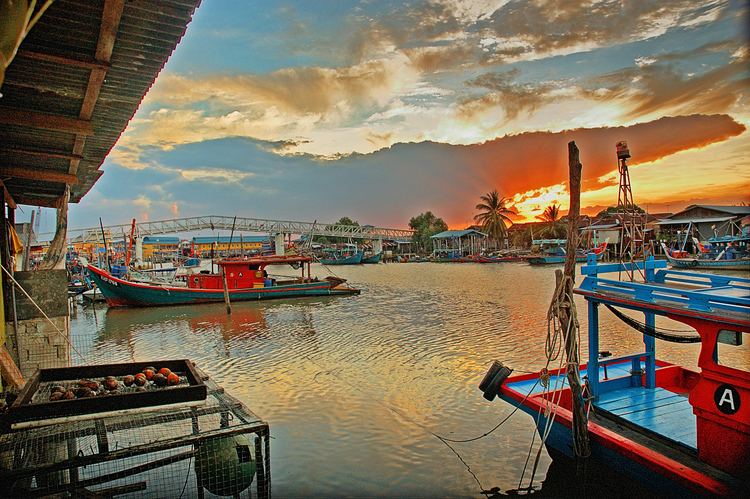Country Malaysian Area 821 km2 Population 240,200 (2013) | Capital | |
 | ||
Map of Perlis
Perlis, also known by its honorific title Perlis Indera Kayangan (Jawi: ڤرليس ايندرا كايڠن), is the smallest state in Malaysia. It lies at the northern part of the west coast of Peninsular Malaysia and has the Satun and Songkhla Provinces of Thailand on its northern border. It is bordered by the state of Kedah to the south. It was called Palit (Thai: ปะลิส) by the Siamese when it was under their influence. Perlis had a population of 227,025 as of 2010.
Contents
- Map of Perlis
- Homestay kangar arau mata ayer perlis
- Tourism destination gua kelam perlis
- History
- Demographics
- Religion
- Languages
- Government
- Tourism
- Recreation
- Malaysian makan aja roti john the best malaysian food makan aja in malaysia
- Malaysian makan aja rojak ibrahim yes the best malaysian food makan aja in malaysia
- References

The capital of Perlis is Kangar, and the Royal capital is Arau. Another important town is Padang Besar, at the Malaysia–Thailand border. The main port and ferry terminal is at the small village of Kuala Perlis, linking mostly to Langkawi Island. Perlis has a famous snake farm and research centre at Sungai Batu Pahat. Among the main tourist attractions are Perlis State Park and Gua Kelam.

Homestay kangar arau mata ayer perlis
Tourism destination gua kelam perlis
History

Perlis was originally part of Kedah, although it occasionally came under rule by Siam or Aceh. After the Siamese conquered Kedah in 1821, the British felt their interests in Perak to be threatened. This resulted in the 1826 Burney and Low Treaties formalising relations between the two Malay states and Siam, their nominal overlord. In the Burney Treaty, the exiled Kedah sultan Ahmad Tajuddin was not restored to his throne. Sultan Ahmad and his armed supporters then fought unsuccessfully for his restoration over twelve years (1830–1842).
In 1842, the Sultan finally agreed to accept Siamese terms, and was restored to his throne of Kedah. However, Siam separated Perlis into a separate principality directly vassal to Bangkok. The Siamese made Raja Long Krok as the Governor of Siam in Perlis while Syed (or Sayyid) Hussain Jamalullail as deputy governor. Finally, on 20 May 1843, the Siamese made Sayyid Hussain Jamalulail, the paternal grandson of a Hadhrami Arab Sayyid immigrant and maternal grandson of the Sultan of Kedah, became the first Raja of Perlis. This made Perlis as a sovereign state. His descendants still rule Perlis, but as rajas, instead of as sultans.
As with Kedah, the Anglo-Siamese Treaty of 1909 forced Siam to relinquish its southern Malay vassal states of Kelantan, Trengganu, and Monthon Syburi (comprising Kedah, Perlis, and Satun which remained with Thailand) to Great Britain. The British installed a Resident in the Perlis Royal capital of Arau. Perlis was returned to Siam in World War II as a reward for Siam's alliance with Japan, but this brief annexation ended with the Japanese surrender. After World War II, Perlis returned to British rule until it became part of the Malayan Union, then the Federation of Malaya in 1957 and lastly the Federation of Malaysia in 1963.
Since 2000, the Raja or hereditary monarch has been Tuanku Syed Sirajuddin. He was the Yang di-Pertuan Agong of Malaysia from 13 December 2001 to 12 December 2006. Tuanku Syed Faizuddin Putra was the Regent of Perlis during the five-year period when Tuanku Syed Sirajuddin was Yang di-Pertuan Agong. The Chief Executive or Menteri Besar is Azlan Man of Barisan Nasional.
The Coat of Arms of Perlis consists of a sturdy green wreath of padi, indicating the wealth of the kingdom and the chief economic activity of the people. The shield in the centre represents the pride of the people. Inside the shield is a ring of golden rice surrounding the name "Perlis" written in the Jawi script.
Demographics
The ethnic composition for the year 2000 in Perlis was: Malay (174,805 or 79.74%), Chinese (21,058 or 9.6%), Indian (2,658 or 1.21%) and others (20,690 or 9.45%).
Religion
As of 2010 the population of Perlis is 87.9% Muslim, 10.0% Buddhist, 0.8% Hindu, 0.6% Christian, 0.2% Taoist or Chinese religion followers, 0.3% followers of other religions, and 0.2% non-religious.
Languages
Majority of Perlis' population speaks Perlis Malay which is a sub-dialect of Kedah Malay but also has its own unique features conpared to those of neighbouring Kedah. Besides that there is also Varieties of Chinese and Tamil as well as small numbers of Southern Thai speakers, mostly ethnic Malaysian Siamese. However, large numbers of Perlisians regardless of ethnic origin mainly uses Perlis Malay as a lingua franca.
Government
Perlis is ruled by the House of Jamalullail. Unlike other Malaysian monarchical states, in which the ruler is a "Sultan", the Perlis ruler is called the "Raja".
Legislative power in the state is exercised by the Perlis State Legislative Assembly, a unicameral chamber in which all 15 seats are elected from single-member constituencies. The United Malays National Organisation (UMNO) is the dominant political force in the state, having held government continuously since Malayan independence. The Barisan Nasional coalition, which UMNO leads, presently holds 13 of the assembly's 15 seats.
Raja appoints Menteri Besar (Chief Minister) and an Executive Council (akin to a Cabinet). Generally the chief minister is a member of the legislative assembly who can command a majority on the assembly's floor. The Raja's appointment powers were at the centre of a brief constitutional crisis in the state after the 2008 general election. The Raja sought to appoint a Barisan Nasional assemblyman, Md Isa Sabu, as chief Minister despite Prime Minister Abdullah Badawi, who led the national coalition, nominating the incumbent Shahidan Kassim to continue in office. The Raja prevailed, and swore in Md Isa, who proceeded to serve a full term as chief minister.
The state elects three members of the federal House of Representatives, for the constituencies of Arau, Kangar and Padang Besar. All three seats are currently held by UMNO. The state also has two federal senators; like all other states, the senators are not directly elected but appointed by a vote of the state legislative assembly.
Perlis, being the smallest state by area in Malaysia, is not divided into administrative districts. Nevertheless, it is still divided into several mukims (communes), namely:
Tourism
Some of the tourist attractions in Perlis are:
Recreation
Outdoor rock climbing in the limestone hills of Bukit Keteri with over 50 sport climbing routes that are bolted by the world's climbing team Mammut & Camp5; the crags split into 2 next to each other and the rockfaces rising up about 350m. The range of difficulty is from beginner to expert and many varieties of climbs are available.
